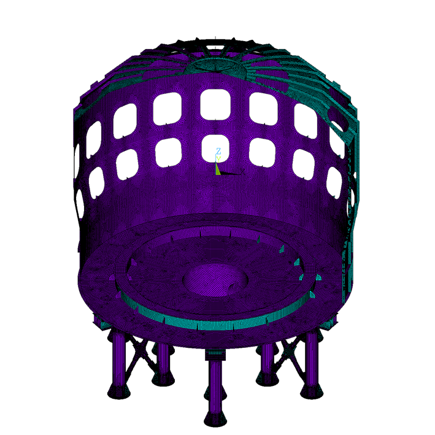 News
News
Effects of seismic isolation on the dynamic behaviour of…
A new scientific paper [1] has been published by the UNITUS Nuclear Fusion Research team, concerning the Italian facility “Divertor Tokamak Test” (DTT) [2]. The aim of this work is to offer a different perspective on seismic isolation, prioritizing stress reduction over examining relative displacements between components. However, further exploration of this other crucial issue is postponed to a later stage. The paper provides a detailed description of the seismic isolation system’s modelling and methodology, along with an evaluation of two different locations for the isolators. The cryostat base consists of a horizontal plate to which the vacuum vessel is fixed. It also houses a reinforcing ring to which the magnets gravity supports are fixed. Beneath the plate are six radial beams, each one supported by two pillars anchored to the ground. A bracing system connects each pair of pillars. Two different seismic isolation solutions were analysed. The first one by placing the isolation plane at the base of the pillars (BISO) and the second one by placing it at the top of the pillars (TISO), below the radial beams. Considering the importance class IV and a peak acceleration between 0.15 g and 0.2 g the seismic hazard level assigned to this project is high. These considerations were the input for the calculation of the seismic local response. The horizontal and vertical spectra used in the analyses are that of the so-called “Collapse Limit State (SLC)”, the most severe case in terms of seismic action with a return period of 1950 years. The behaviour of the toroidal complex of the DTT fusion machine has been analysed in using both static and spectral analyses based on the most severe local seismic response spectrum of the Frascati site. Given the high stresses on the cryostat base under these conditions two seismic isolation were studied. Both systems showed significant benefits with respect to the non-isolated configuration, reducing the maximum stresses by an order of magnitude. Of the two isolated configurations, TISO is the one that guarantees lower stresses in the cryostat base, despite the difference is quite low. Taking into account the seismic isolation, a comparison was also made between the analytical results obtained using a simplified 1 “degree of freedom” (DOF) model and the numerical results in terms of horizontal displacements of the system. The numerical results did not differ significantly from the analytical results, up to a maximum value of 15% in the BISO configuration, making the 1 DOF model a valid option for first-attempt calculations. The paper highlights some preliminary results without identifying an integrated solution implementing real seismic isolators. Further design and analysis activities will be performed concerning the isolation devices, the control of undesirable movements, differential seismic ground motions, the control of displacements relative to surrounding ground and constructions.
References
[2] R. Martone, et al., DTT Divertor Tokamak Test facility Interim Design Report, ENEA (2019).
